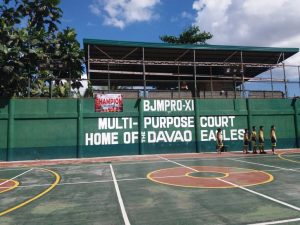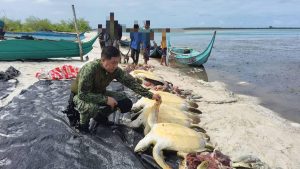WHEN news reached Dr. Daniel David that Patient X died of pulmonary congestion secondary to end-stage renal failure at the Southern Philippines Medical Center on Nov. 19, it was just another one of many.
As the regional health chief of the Bureau of Jail Management and Penology-Davao, he receives daily situational reports on each of the patients in isolation and in the infirmary. After he was notified that the patient was rushed to the state-owned hospital, he was not a bit surprised.
After all, Patient X has been undergoing dialysis for a long time. And unfortunately, in his line of work, death is not a stranger. Dr. David was already in his office in the “cold zone” when he received the report from SPMC on Friday, Nov. 20. As part of the admission protocol of the SPMC, the patient was subjected to a COVID-19 test.
Their worst fear was realized: Patient X was positive for the novel coronavirus.
“When everything is contained, speed is essential,” he said. “Things can go worse quickly if we don’t move fast.”
The BJMP-Davao already has a contingency plan in place since March to prepare for such a scenario. They also performed several simulation exercises for the jail personnel and the PDLs.
“But it’s different when you are facing the real thing. Something always comes up that was not in the manual and you improvise,” he explained. “You have heard of widespread transmissions in other jail facilities and you don’t want it to happen under your watch.”
When he signed up to become the regional health officer, Dr. David never anticipated a challenge of this magnitude in terms of scale and urgency. He used to run a private practice in Digos City, about 50 kilometers away from Davao City, from 2013 to 2017. As luck would have it, he was hired on a retainer basis as the health officer of the Digos City jail.
The physician loved his experience so much that he accepted the offer to become the regional health chief of BJMP-Davao in 2018. He transitioned into his new life smoothly even if he had to adjust to the new schedule and the added responsibility. With the rank of a senior inspector (equivalent to a captain), he is not only considered a medical expert but also performs the tasks as a jail officer, as well.
Lockdown

The Davao City Jail has been on lockdown starting March 20 to protect the persons deprived of liberty (PDLs) following Presidential Proclamation 922, which effectively placed the Philippines under a state of National Public Health Emergency.
As part of the lockdown measures, personal visitation is suspended and family members or relatives are no longer allowed to bring in food to the PDLs.
The entire facility is split into two classifications: hot zone and cold zone.
Food and fresh produce are only accepted from accredited concessionaires, which unload the supplies on a secure area in between the hot and cold Socialization and regular physical activities were scaled down.
The correctional facility was divided into blocks and the PDLs can only mingle with other detainees within their block. The warden also divided personnel into three groups, with each batch staying in the facility for 21 days. When their schedule shifts, they will stay in home quarantine for another 21 days before repeating the cycle again. They will be screened and their RT-PCR test should reflect a negative result before they are allowed to render duty.
A laboratory for an outbreak
Philippine jails are notorious for being overcrowded and underfunded.
The BJMP, and by extension the Duterte administration, has been accused of covering up the real numbers in terms of COVID-19 transmission among the PDLs.
The Human Rights Watch (HRW), in its April 28, 2020 report titled, “Philippines: Prison Deaths Unreported Amid Pandemic,” claimed that seven detainees have died to COVID-related causes since March 20. But the group suspects that the toll could be higher.
Phil Robertson, HRW deputy director for Asia, called on the government to be more transparent about the transmission and death toll in the country’s overcrowded jail facilities.
“The government should get serious about the terrible situation in its prisons and jails and accurately report on prison deaths and illness,” he said.
To its credit, the Philippine government worked on hastening the cases for review to decongest the jails. In May this year, the Supreme Court ordered the release of detainees across the country after more than 330 detainees from the Cebu Provincial Jail have tested positive for the virus.
In Muntinlupa, the national penitentiary, 140 inmates were infected as of June 2020. In his order, Chief Justice Diosdado M. Peralta said that rushing bail proceedings and releasing the detainees on “recognizance” will help stem the transmission inside the congested facilities. The Republic Act 10389 defines recognizance means securing the release of a detainee who cannot post bail due to “abject poverty.”
By October, more than 80,000 detainees in the country have so far been released following the High Court’s initiative.
TB experience
The issue of congestion of the Philippine jails should never be underestimated.
According to the International Committee of the Red Cross, TB is more prevalent in prisons than elsewhere. Based on the BJMP data, the congestion rate for 467 jail facilities in the Philippines is nearly 600%. The city jails are in worse condition since the congestion rate has skyrocketed to over 700%.
But the government also recognized the problem as the Department of Budget and Management had released nearly P3 billion to construct additional buildings to decongest existing jails in its 2019 budget.
In Davao Region, the BJMP XI has successfully decongested the Davao City Jail when it transferred half of the previous 3,000 total number of detainees to the Davao City Jail Annex. While it can’t be helped that each cell is already stretched past its designed capacity, at least a semblance of physical distancing can be imposed.
Thankfully, the government can draw on its experience in curbing TB infection in adopting measures to slow down the coronavirus infection. For instance, isolating the patient and enhancing the screening measures are not novel measures being used for COVID-19.
Dr. David said they already have systems in place to contain infections and prevent an outbreak.
In the Davao City Jail, infectious skin diseases such as warts and boils are quite common. They are quickly separated in the isolation unit until they are fully recovered. Since March, the infirmary and the isolation unit have become a musical chair of incoming and cured patients who were diagnosed with mild upper respiratory illnesses, hypertension, skin diseases, and tuberculosis.
A glaring mismatch
One challenge by Dr. David is the health team itself, which is composed of two nurses, one medical technologist, and two psychologists. When you consider the jail population of over 1,700, contact tracing seemed an insurmountable task.Luckily, the previous decision to contain the PDLs into each block and isolate the vulnerable cases came in handy.
“Our nurses already received training on how to do contact tracing using the spiral method,” he said. “Since speed was essential, they immediately went to work.”
The spiral method enabled the nurses to identify detainees who were in close contact with Patient X, and work their way from there.
As the smoke cleared by the end of Saturday, 68 PDLs and eight personnel tested positive for coronavirus.
The detainees were immediately herded to the 100-bed isolation unit within the compound of the facility while the jail personnel continued their recovery at the facility of the Department of Health.
Dr. David said that they also need to consider the mental health of the PDLs. The lockdown meant that some privileges of the detainees had to be taken away. For example, their regular exercises were reduced to 1-2 hours each day. Movie nights were scaled down to once a week.
Mingling was discouraged and they can’t kiss or hug their wives and children. Since the nationwide lockdowns and work-from-home schemes were implemented in March, people have complained of cabin fever. They experience the stress of staying at home, isolated from their loved ones and friends. As a result, they feel bored and irritable.
But do PDLs, who are used to piecemeal freedoms, also experience the stress brought about by the added restrictions?
“That is what we are monitoring–their mental health,” he said. “As of now, we are happy to note that we have not received any case of depression or a PDL who has suicidal tendencies.”
One approach they implemented was to solicit the help of the detainees to also observe their co-PDLs for any red flags that may point to anxiety or depression. Group sessions also include training on how to spot persons suffering from mental health. As an added benefit, the detainees are also more cognizant of their own feelings and seek help immediately. The mechanism worked wonders for early intervention considering that the BJMP health unit has limited personnel.
E-visit and e-counseling
As early as April, the BJMP implemented its telepsychology program, which utilizes technology for virtual counseling to replace face-to-face interactions, for both the PDLs and jail personnel.
The program proved to be a palliative method to improve the sleep quality of the patients, reduce their anxiety, and improve their overall mental health. The BJMP also created hotlines manned by trained personnel to receive distress calls 24/7. Among the psychological interventions adopted by jail facilities nationwide include cinema therapy, meditation and other relaxation techniques, stress management, and group or individual psychotherapy.
While the techniques are universal, they can also be calibrated by the psychometricians and welfare and development officers to fit the needs of the respective facilities where they are assigned.
For the e-visit, the Davao City Jail utilized the units in its computer laboratory for the e-visits to help boost the morale of the PDLs. Each detainee is given a maximum of 20 minutes to see and talk to their families via video conferencing.
Jail Insp. Edo Lobenia, the spokesperson for the BJMP-XI, said back in April that the e-visit is also part of the transparency initiative of the bureau to assure family members that their detained loved ones are healthy and well. They thought of the alternative so that persons deprived of liberty and their families can still communicate with each other amid the pandemic.
Who watches the guards?
BJMP psychologist Erna C. Compuesto, who supervises Central Luzon, Davao Region, and Soccsksargen, said they already have psychological intervention programs in place that can be tailored to fit the needs of each specific facility.
Ever since the lockdown at the Davao City Jail in March, the BJMP already suspended face-to-face individual and group counseling for the safety of both psychotherapists and the PDLs. However, she is more concerned about the BJMP personnel whose increased isolation and extended stay.
“The PDLs are already used to the mindset of a lockdown. But it is different with the personnel who have to be away from their families when they are on duty for extended periods,” she said.
Nowadays, she counsels five jail personnel each month on average from the three regions and the national headquarters, due to stress and anxiety.
However, a vast majority simply needed to unload their intense emotions. “They immediately went back to duty after the counseling,” she said.
She only knows of one case when the person had to be pulled out for depression. They recommended that the individual should take a break for medication and psychotherapy. Compuesto admits that the BJMP psychologists and psychometricians are overwhelmed by the gargantuan task of making sure the PDLS and the personnel are mentally healthy.
“We only have five registered psychologists in the country so we have to make sure that the regional psychometricians are equipped with the right knowledge and training to deliver services under the new conditions,” she added.
Lessons learned
Dr. David said they need to revisit their COVID-19 safety protocols and contingency plan to address the gaps.
One thing he learned from the recent outbreak is to be decisive. But through simulation exercises, they already laid the groundwork to improve their success.
“We also made sure to refresh the training of our personnel so that they know what to do,” he said.
The recent outbreak also affirmed the efficacy of their contingency plan. Breaking the entire compound into sections and limiting detainee contact within each block worked to contain the infection. If no systems are in place, the situation could have been worse.
Also, the stricter checks on incoming medicines, food items, and other goods have yielded the added benefit of detecting contraband. On Dec. 26, two individuals were arrested after attempting to smuggle nearly P2-million worth of shabu (Methamphetamine hydrochloride) into the male dormitory. They stuffed the illegal drugs in packs of noodles.
More than anything, he learned the need to be compassionate. He constantly reminds himself that the PDLs are human beings first and foremost. When you talk to them and treat them with dignity, they respond back with respect. For example, he recounted the initial paranoia that set in after the news of Patient X spread like wildfire.
The last thing he wants is mass hysteria inside the jail compound. But the PDLs were not panicking because they might be infected, which meant they have ample knowledge about COVID-19 and its implications. “It turned out that they were scared of the swab test,” he laughed. “We had to assure them that it does not hurt as much as they think.”
Who is patient zero?
But one puzzle remains: Who is the index case?
Identifying the point of contact will help provide the final piece of the puzzle. Patient X was already isolated from the general population owing to his condition. Could it be one of the jail guards? A member of the medical team?
The index case would help also spot the lapses in their safety protocols and fill those gaps to prevent a repeat of the incident. Dr. David said, “We may never know who patient zero is because it is almost impossible to trace the source with our limited personnel.”
But he quickly added that it might not be needed anymore since they are constantly assessing their COVID-19 safety plan to determine its efficacy. More important than finding patient zero is to ensure that the Davao City Jail remains COVID-free. “As of today (Dec 22), we now have zero cases of COVID and we aim to keep it that way,” he said.
About the author: Joel B. Escovilla is Associate Editor of Mindanao Times.) The production of this special report was made possible with support from the Information Saves Lives project of Internews.





